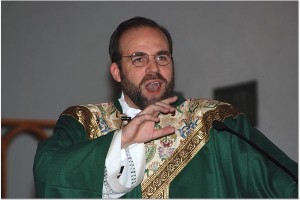The Incensation of the gifts and altar. Holy Smoke! Here we go again. Out comes the incense. Actually, most Sundays in most parish you won’t see this. Incense as we have discussed before is used only on more solemn occasions in most parishes. There is no norm restricting it only to more solemn occasions but this does seem to be the case. Recall that incense is a symbol of prayer as we see from the Psalm “Let my prayer rise like incense and the lifting of my hands as an evening offering.” (Psalm 141:2) Incense is also a “burnt offering.” In the Old Testament many of the animal offerings were either partially or wholly burned up in a fire. In effect, to burn something was to give it to God. The notion may seem primitive, but consider the basic facts. You put something in the fire and it is burned and much of it turns to smoke and rises up, that is goes up, to God. The rising smoke is a symbol of the gift going up to God. In the offertory context of the Mass this aspect of the burnt offering is most evident. Our prayers, and our sacrifices are going up to God as a fragrant offering. So this is holy smoke: a prayer and an offering.
So at this point in the Mass the gifts of the altar and the altar itself may be incensed. Afterward the deacon or other minister may incense the priest and the people. Here too note something important. As we discussed earlier, we are not only offering bread and wine (and money) we are offering our very selves. Hence it is appropriate that the people be incensed along with the other gifts.
The priest puts some incense into the censer and blesses it silently with the sign of the cross. The altar is incensed in this manner:
- If the altar is freestanding, the priest incenses it as he walks around it.
- If the altar is attached to the wall, he incenses while walking first to the right side, then to the left side.
- If there is a cross on the altar or near it,the priest incenses it before he incenses the altar. If the cross is behind the altar, the priest incenses it when he passes in front of it.
History – We have already discussed a good bit of the history of incensation. (HERE) This will largely suffice for here. However, there are some particulars of the incensations of the gifts that remain to be discussed. The History of the incensation of the gifts is first traced outside of the Roman liturgy. It is most precisely the fruit of the Carolingian liturgy in Germany and France. As late as the 9th century the use of incense at the offertory was unknown in Rome. There was the practice of burning incense in fixed stands as well as carrying it processions. However there was no elaborate incensing of the gifts such as we know it today. By the 11th century however, the act of incensation was a part of the offertory in Roman usage. With this act came to be elaborate prayers and recitation of psalms. There was a prayer when placing the incense in the thurible, while swinging it and even when handing the thurible back to the deacon or thurifer. In addition to the gifts, the celebrant other concelebrants, the deacon and the people are all incensed as well.
In the Extraordinary form of the Latin Mass the use of incense is restricted to solemn high, and high (sung) Mass. Today the use of incense is always an option. While it is no longer required at a solemn mass, it is also no longer restricted to that form either. In addition, the manner of incensing has been simplified a bit. Some of the more elaborate directives about the manner of swinging it have been dropped. In addition, the prayers are no longer prescribed.
Pastoral implications – The incense as we have seen is a traditional symbol of our prayers and offerings going up to God. Hence, it is a vivid symbol at the time of the offertory. Likewise, the incense being consumed is an allegory of our self-giving to God. The practice of incensing the priest and the people is first of all a sign of respect. It is also a visual image of the fact that we are united to our offering upon the altar. Bread and wine are offered but so are our very lives. The use of incense at this time should not be considered another offering of its own but rather as a compliment to that which has already been offered. And remeber, breathe in that incense it is blessed! It is holy smoke and to breath in some (obviously in moderation) brings blessing!
Here is a video of the gifts and altar being incensed in the Extraordinary Form (Latin) of the Mass:


